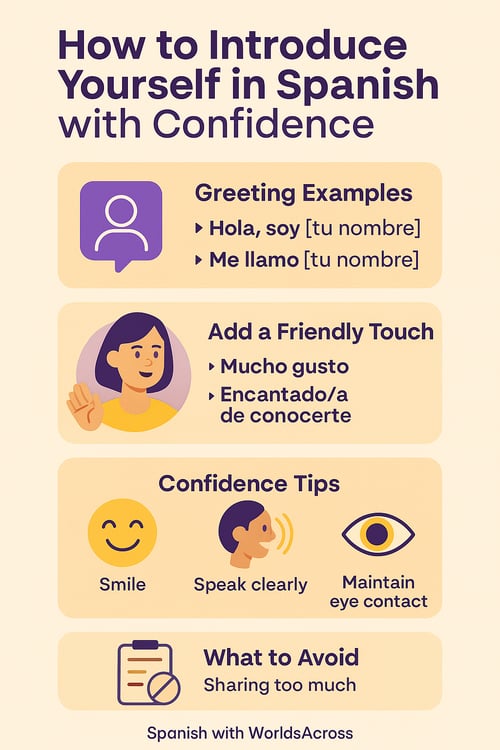Introducing Yourself with Confidence in Spanish

Have you ever felt nervous when you had to introduce yourself? Don’t worry—it happens to all of us. Feeling nervous is completely normal, especially when you're doing it in a language that isn’t your own. However, knowing how to introduce yourself in Spanish with confidence can open many doors, from connecting with new people to standing out at work. In this article, I’ll show you how to do it in a safe and effective way that leaves a great impression. Let’s get started!
Taking the First Step Toward a Great Impression
Remember the saying, “First impressions matter”? It’s very true! The first words you say are incredibly important. But don’t overcomplicate it—you don’t need advanced vocabulary. It’s best to start with something simple and effective, like:
- Hola, soy (your name), mucho gusto.
- Hola, me llamo (your name), es un placer conocerte.
These phrases are simple but very effective. If you practice them often, they’ll start to come out more naturally and fluently. And here’s a bonus tip: if you want to leave an even more positive impression, accompany your words with a smile!

The Key to Confidence: A Positive Attitude!
To introduce yourself confidently in Spanish, it’s important to pay attention not just to what you say, but how you say it. People who are self-assured know that a good attitude often says more than words alone. Here are some tips:
- Smile! Introducing yourself with a serious expression isn’t the same as doing it with a genuine smile. Smiling not only makes you look more approachable, but it also shows that you're friendly and trustworthy. Try it—you’ll notice the difference!
- Keep an appropriate tone of voice: Your voice plays a key role in conveying confidence. Avoid speaking too softly or passively. You don’t need to shout, but your tone should be firm and assured. That will make your words sound more convincing.
- Speak calmly and pause: When we’re nervous, we tend to speak faster, which can make us sound unsure and harder to understand. Take your time, breathe between sentences. Speaking calmly and clearly is much more effective than rushing through your words.
- Make eye contact: Don’t avoid eye contact when introducing yourself. Looking someone in the eye shows confidence and sincerity.
- Mind your posture: Your body language is almost as important as your words. Great phrases won’t help if your body says otherwise. So stand tall, relax your shoulders, and let your posture reflect your confidence.
Phrases That Will Make You Shine in Any Introduction
Knowing how to introduce yourself in Spanish isn’t just about what you say, but also how you say it. While classics like "Hola, me llamo..." or "Mucho gusto" work well, here are some additional ways to make your introduction more interesting:
- Es un honor conocerte. – It’s an honor to meet you.
- Encantado/a de conocerte. – Delighted to meet you.
- Es un privilegio conocerte. – It’s a privilege to meet you.
- Es un placer poder conocerte. – It’s a pleasure to get to know you.
Now you know! If you really want to learn how to introduce yourself in Spanish with confidence, start practicing these phrases. You won’t regret it!
Mistakes to Avoid When Introducing Yourself
Nice job! You're on your way to mastering how to introduce yourself confidently in Spanish. And remember—it’s totally okay to make mistakes at first. Everyone does! But to help you prepare, here are a few of the most common mistakes to avoid:
Mixing up “ser” and “estar”
Don’t worry—we won’t dive too deep here. Just remember: use ser for professions or permanent characteristics, and estar for locations or temporary states.
- ✅ Correct: Hola, me llamo Matías, soy veterinario.
- ❌ Incorrect: Hola, me llamo Lucas, estoy arquitecto.
Sharing too much unnecessary information
Sometimes, when we’re nervous, we tend to overshare.
- ❌ Common mistake: Hi! My name is Samuel, I’m 28 years old, my favorite color is green, I love sports, and I dream of traveling the world.
- ✅ Better: Hi! My name is Samuel, I’m an art teacher. It’s a pleasure to meet you.
See the difference? To introduce yourself confidently in Spanish, you don’t need to share too much. A clear, simple sentence is more than enough.
End on a High Note: Your Perfect Introduction!
Mastering how to introduce yourself in Spanish isn’t just about saying your name—it’s about courtesy, attitude, body language, and most importantly, confidence. It might feel intimidating at first, but the more you practice, the easier it gets.
So now you know: next time you need to introduce yourself in Spanish, take a deep breath, adopt a positive attitude, and say with confidence: “¡Hola, me llamo (your name), es un placer conocerte!” You’ve got this!


